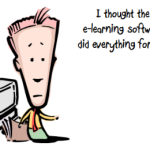Excellent post Tom. Spot on!
9 Ways to Encourage the Adult E-Learners
October 4th, 2011
Recently I spent the day at the beach watching people learning to surf. One of the people learning to surf was a blind girl. It was very inspiring as she learned to balance on the board. She probably fell off of the surfboard a few dozen times before she successfully stood and balanced on it. And when she finally succeeded she let out a cry of joy.
Learning is a funny thing. It’s not something that can always be neatly packaged. Real learning isn’t a one-time event (like many elearning courses) where it’s just a matter of getting new information. Instead it’s an iterative process where you do something, get feedback to evaluate, make adjustments, and do it again.
E-learning courses are an intrusion to the natural learning process. With good planning, it’s a welcome intrusion because we can compress time and create cost-effective and repeatable learning events. For example, if I was training operating room techs on setting up an operating room in the real world there’s the cost of pulling a room offline for training, coordinating staff, and maintaining a sterile environment and tools.
But in an elearning course, I have a room and equipment that is always available. If someone fails or needs more time, they have it. That’s one of the good things about elearning. The challenge though is to craft a great learning experience.
Adult Learners Don’t Like to Fail
Going back to the blind surfer, it takes a lot to fall down and continue getting up. I saw plenty of other surfers give up after a few tries. Few people like to fail and then do so publicly. This is especially true of adult learners.
Elearning presents a great opportunity to let people fail (or practice becoming successful) in private and in a safe environment. Unfortunately a lot of elearning fails to exploit this opportunity with our need to score and track everything.
As learners, our culture conditions us to avoid failure. Typically our grading systems reward successful test taking more than successful learning. Because of this, we’re motivated to pass tests and getting good scores and not always focused on the learning process.
Embrace the Learning Process
Here are some things to consider when building elearning courses:
- Set clear expectations and objectives. Let them know why they’re taking the course and what they should be learning. People like to get oriented and know what’s expected of them.
- Adult learners don’t like to fail, and they don’t like to fail publicly. Make it clear when they are being tested and when they aren’t.
- Create an environment where they have as much freedom as possible. Let them click around and explore. I know that many customers want to lock navigation so that they “get all of the information.” This is faulty thinking. If they need to confirm their grasp of the information, then give them exercises to practice applying it so they can demonstrate their understanding in a real way.
- Give them ways to collect information. This is a great way to counter the locked navigation issue. Create situations where they need to make decisions and then free up the navigation to collect the information needed to make decisions. This is a much better way to assess understanding than viewing a screen full of text.
- Focus on relevance. I’ve worked on plenty of projects where the learners are never considered. I recall one company I worked for that wouldn’t let me talk to any potential learners, even though we were rolling the training out to 3500 people across the country. If your content isn’t relevant to the learners, they’ll just tune out and you’re wasting time and money. You can guarantee that little learning will happen.
- Create a visual design that is friendly and inviting. This helps with the initial engagement and sets the tone of the course. I’ve had customers tell me that they can’t do that because the subject matter was real important and serious. So they needed to have a very serious tone (read boring). If it’s important, than it makes sense to create a course that’s as visually inviting as possible.
- Elearning is a multimedia experience so it makes sense to leverage as much of the multimedia as you can (in context though). You don’t want to add multimedia for the sake of it, but you do want to use all of your resources to create the best course possible.
- Free Willy! People are like orcas with floppy dorsal fins. They yearn to be free. One of the worst experiences in elearning is when the course navigation is locked. There are better ways to help people learn. Focus on relevant, decision-making scenarios. And if you’re building a compliance, click-and-read course with no performance expectations, then make the course as simple as possible so that the learners can get in and out. Don’t frustrate them or waste their time with a bunch of extra branched scenarios. Tell them what they need to know and let them go.
- Do you need to test everything? Every day we take in all sorts of information that is critical to meeting our goals. When my boss sends an email detailing new plans, he doesn’t follow it up with a quiz. Assessing a person’s understanding is an important part of learning, but do we need to always have a test? In many ways it retards the learning process. As soon as people find out they’re being tested, they quit learning and focus on how to pass the test. If you don’t need a test, don’t include one. If you do need to assess their understanding, perhaps there’s a better way to do so.
The blind surfer was motivated to learn and willing to risk failure as she kept falling of the surf board. She might not have been as inclined to do so if she was only allowed two attempts and then notified that she failed.
The main point in all of this is that elearning presents a unique opportunity to compress time and offer repeatable events where people can practice and get feedback. But we need to craft an environment that encourages learning (which is not the same as exposure to information).
Focus on that part of it and you’ll build good elearning courses. Focus on controlling the learner and creating points of friction and you’ll squander the opportunities.
What are some things you do in your courses that help the learners feel comfortable and want to learn? How do you handle the client that asks you to lock navigation so that they can be assured that the person learned by “seeing all of the information?”
Feel free to share your thoughts by clicking on the comments link.
Events
- Everyday. Check out the weekly training webinars to learn more about Rise, Storyline, and instructional design.
Free E-Learning Resources
 |
 |
 |
|
Want to learn more? Check out these articles and free resources in the community. |
Here’s a great job board for e-learning, instructional design, and training jobs |
Participate in the weekly e-learning challenges to sharpen your skills |
 |
 |
 |
|
Get your free PowerPoint templates and free graphics & stock images. |
Lots of cool e-learning examples to check out and find inspiration. |
Getting Started? This e-learning 101 series and the free e-books will help. |
49 responses to “9 Ways to Encourage the Adult E-Learners”
[…] Read the original: 9 Ways to Encourage the Adult E-Learners » The Rapid eLearning Blog […]
Great post Tom !
Great suggestions! I teach a lot of graduate classes and have recently been changing some of my approaches to teaching. I’ll be sharing this post with my readers at http://www.delaneykirk.com
“She might not have been as inclined to do so if she was only allowed two attempts and then notified that she failed.”
This whole post hit very close to home, but this sentence resonated with me the most.
I find it very difficult to convince management that testing every piece of content delivered to our audience isn’t necessarily the best approach.
I’d love to hear what other ways people use to assess understanding that pleases management, but doesn’t scare away learning. 🙂
Excellent, excellent! For adult learners, especially for job-related training or education, application is the key! Learners have so many other things to do that if you can’t help them see why what they’re learning helps them do the job, they are not motivated to complete what you’ve spent so much time developing.
Traditional testing can be ok when really necessary but there is no better way to determine whether the learning is relevant and the learner is grasping the content than to have them complete application exercises and decision-making scenarios.
Thanks, Tom!
I am developing a self-study CBT of a State regulation that covers license requirements so this is more of an information CBT and not a performance one. Currently I have been referring them to a section of the reg for them to review, then giving them a quizmaker survey for them to use to interpret in their own words, then giving them a full feedback of what should have been included. Any ideas of how to make this more entertaining?
Thanks for sharing this! I really appreciate it.
Some interesting insights – whether designing a course or managing a class.
With all of the other insightful information, we might easily miss the “power of a story!”
If you follow the first link in this post you will find another link to Cathy Moore’s Action Mapping page. Don’t miss the 31 slides in that presentation.
Wonderful post! Testing is a big issue in some elearning courses, where the goal is to learn and retain information. Instead of testing, I think utilizing activities where participants put their knowledge of the material to use are a lot more fun and less tedious. From these activities, participants also leave the course with something tangible they’ve MADE from all the information they’ve LEARNED.
I do think that quizzes and tests can be disguised better as a game or activity – I wish that you could turn off the results page in Quizmaker (maybe you can and I just don’t know how to do it) so that the learner isn’t bothered with a score. I want to know how the learners are doing, but it is more about me than it is about them…if they are doing well, then the lesson hit the mark. If not, then we need another way to get the information out there.
I do agree – some people just get their back up when they get a quiz plopped in front of them. But disguised as a game or activity, they might just find it fun.
Tom, excellent article!!!
Thanks
Carlos
I’m a big fan of:
1. Including a clean, clickable Table of Contents on the screen. Learners can navigate to what they need, skip what they don’t care about and replay what they need to know as many or as few times as they’d like.
2. A small display of the course length at the bottom of the screen to let them know they won’t be straining through ‘corporate’ content for eons (course length for our processes are usually 5-15 minutes each).
3. In lieu of testing, posing a relevant, taken from real life question and answering it by displaying what to do. Slide 1: What if my employee resigns after adopting infant triplets from Kazakhstan? Slide 2: After speaking with the employee and HR, shopping for a baby gift online, and validating last day of work, navigate to screen A and click the B button.
Tom, I appreciate your straightforward advice. One point I want to touch on is that concept of the visual design.
I am all game for intuitive navigation, but a lot of companies, especially ones that have a strong brand tend to focus more on their learning looking like one of their products instead of being great learning.
Does the learning module need to have the same color scheme as your corporate website? No!
Put the learner in a messy cubicle, your elearning can do that! Believe me, no one, except the marketing dept, is going to complain that the company logo was not on the t-shirt your avatar was wearing. Its about realistic situations where people make realistic decisions. Breaking out into the real, uncoordinated world for some examples is a good thing. Breaking some “rules” is OK because we can make new “rules”.
[…] the adult e-Learners [Tom Kuhlmann] On 10/04/2011, in adult learning, by Daniel Christian 9 ways to encourage the adult e-Learners – from The Rapid E-Learning Blog by Tom Kuhlmann If you enjoyed this article, please […]
You are a special person and your blog is very important to me. I read all your posts with great pleasure.
Hi Tom
So nice to hear that others feel the same way I do 🙂
I am my own customer and sometimes have to fight others (read other senior staff)for the understanding that we don’t always need tests, either tacked on or as part of an e-learning scenario. I like to test my teachiing by observing behavioural change and getting feedback from the learners on how these projects change their thinking on the tasks taught.
Your posts are always great – just another good one.
Cheers
Sue
I liked this post a lot. When you said that creating a learning environment is not the same as creating a place where there is exposure to information, I realised where I need to correct myself. Thank you very much.
Thank you for your insight, reminder: learning is iterative, and when learners have opportunities to fail and have some control, it can be meaningful. Absolutely perfect post.
Hi Tom,
I really liked this part of the post “Learning is … Instead it’s an iterative process where you do something, get feedback to evaluate, make adjustments, and do it again.”
I want all my e-learning to be like this, which will encourage the learner to learn and not be bogged down by tests and assessment.
Really motiviating post.
Regards,
Cheryl
Hi Tom,
Enjoyed reading your post and just wanted to add one comment about lifelong learning. Lifelong learners don’t necessarily want to be part of a ‘course’, as such. To use your surfer-learner as an example, she may have just wanted to try it once to see what it was like. From that point she may choose to pursue more surfing learning experiences, or not.
In any learning situation, people will have varying goals and perspectives on accomplishment. I think one challenge we all have as developers of learning materials is to design them and develop them in a way that allows for as many different types of learners with all of the variety of goals they may have. In other words, the learners should have the capability of dipping in or opting out as they like.
Regards,
Dean
Excellent post and how true!!!Adults and for that matter even children hate failing.The objective of elearning should be to enable every learner to pass by providing feedback and opportunity to relearn.Giving learners options to decide how they learn is the best way to motivate them.I am yet to hear of some one who has not learn to cycle or swimming.Only the speed at which they learnt differed.
You’re right, Tom – we need to warn learners that they are being tested before they begin. When you can’t get out of giving the test, give ’em a heads up.
The other point that sticks with me is the inexplicable business need for testing and tracking. I have pages and pages of data on associates who passed the quiz, but who probably froze the first day on the job and never made it a year. That’s the actual assessment: can they do the job?
I recently launched a pilot of a new course for call center associates that has no assessments. The new system applies business rules and only allows the associate to enter specific information at a specific time. The job became less about data entry and more about helping the customer by better probing and problem-solving. The trainers were surprised and a little nervous, but they also knew that trying to assess performance with pat, simple scenarios would not be of any use – it would give them a false confidence.
I’m one of the few on my team with such flexible and “let’s give it a try” business partners – they understand how changeable the job really is, from phone call to phone call. But it took a very long time to get there, and not all of my business partners have the same attitude. OJT, either formal or the ramp up time immediately following the lesson, should be used as the assessment. Keep after your business parters to bring them around to true performance assessment, or work on converting them one at a time.
End of rant. 🙂
Great point about leaving the navigation unlocked. Ultimately, it’s a sign of respect to the learner to let them know that it’s up to them how they will experience and interact with the content. Respecting the learner is the essential first step for every online course – but particularly important in adult learning.
One way of ensuring maximum freedom for the learners is to present them with a scenario/case study at the beginning of each module. Then add instruction text such as: “The clues to solving the scenario/case study is hidden in the pages of this module itself. You just need to detect the clues and piece them together.
However, if you are the “I cannot do this” kind of a person, click the “I give up” button at the bottom of the scenario.”
I think the “discover the answer yourself” theme of above paragraph would fetch the attention of many learners. After all people are curious by nature and most of us want to feel good about about our own abilities, intelligence especially.
And very few people like to admit (even to self) that they are the “I cannot do this” kind of people.
If a client insists on having locked navigation in a course, I don’t think we developers can do anything except maybe giving him reasons once or twice why locking navigation buttons is not a good idea. But, the client is the owner of the course and we have to play along.
Tom,
Really enjoyed your blog post, and I’m responding in response to an assignment for the Assessment Techniques master class. Throughout this process, I see the usefulness of your suggestions for adult learning…in fact, when attending trainings for DOD, I find myself critiqing the presentations of others according to what I’ve learned. I’m excited and trepidatious about beginning the work on my own website…but I have one concern. I was told the work for my Masters degree would all apply to whatever we were doing in the classroom. I can see how all of the e-learning tools could be useful in a public school classroom, but can you give me some ideas for ways in which I might put the technology to good use in a Dept. of Defense based school…we are limited very strictly about what we can provide to students!
Great! Every post opens my eyes wider on adult elearning. And all these things work.
Thanks Tom.
[…] 9 Ways to Encourage the Adult E-Learners […]
[…] on shortening Web-based training, read this great article from The Rapid E-Learning Blog entitled, 9 ways to Encourage Adult E-Learners. LD_AddCustomAttr("AdOpt", "1"); LD_AddCustomAttr("Origin", "other"); […]
I never get tired of teaching adults. They come prepared and ready to learn (no attitudes of “I know it all.”) and eager with a thirst for knowledge of technology. Sure it’s important to keep jargon and steps simple for understanding. Repetition also helps. After catching on, they tell me that they, surprisingly, feel younger.
Based on my experience, adult learners in a business environment can be quite resistant to acquiring new knowledge and developing new skills IF there is no reward at the end of the process. Why would an employee go through an e-Learning module if it will not result in a promotion, a pay raise, or being selected employee of the month? Will it suffice to say ‘the company needs you to learn this….’?
It is nice to have well-designed e-Learning modules, captivating graphics, relevant and concise information, ease of navigation, and sequentially organized to deliver an outstanding learning experience. However, none of the above will matter unless my brain is convinced that (1) I need this knowledge and (2) there will be some kind of reward for me once I learn it.
Paulo Castro | http://www.fullminddesign.com
Thanks for sharing. I am just starting to redo some courses that have locked navigation.
Firstly let me say: a great post. I train visually impaired people to use ICT and am aware of the sensory ‘lock in’ that can ‘lock out’ others from being able to deliver appropriate training.
I’ve been advocating androgogic (lead by men) teaching principles for some time, which you rightfully highlight, but the problems start with so many adults given so little choice in certain (business) cultures…this effectively brings in good old fashioned pedagogy (leading children) which only works so far. I’m also very interested in how groups can learn together, given an opportunity to use cross talk effectively.
This is so true. E-learning has many benefits, but it has to appeal to its audience in order to be effective. Keep up the great work!
What a great understanding of the adults’ pride you have stated on your post. E-learning is a learning experience in itself. For adults such as myself who decide to go back to school and enroll in a distance-learning program, there will be some moments of frustration. There is still the preference for traditional classroom learning environment where the face -to- face interaction is alive for immediate questions and answers. With the advancement of the electronic age, the expansion of globalization, and the freedom to work independently, E-learning is attractive. E learning is convenient for working and older adults like me as long as the lessons and the sites are well organized.
Tom, the most frustrating part of E-learning is to find what you want, the subject/topic that need to complete your assignments. Adults‘ pride sometimes gets on the way. We ask for help. As a person matures, his or her self-concept moves from that of a dependent personality toward one of a self-directing human being (Knowles, 1980). The question is E-learning for every adult learner?
Knowles, M. S. (1980). The modern practice of adult education: From pedagogy to andragogy (2nd ed.). New
[…] 9 Ways to Encourage the Adult E-Learners de Tom Kulhman […]
[…] http://www.articulate.com/rapid-elearning/9-ways-to-encourage-the-adult-e-learners/ Share this:TwitterFacebookLike this:LikeBe the first to like this post. […]
[…] http://www.articulate.com/rapid-elearning/9-ways-to-encourage-the-adult-e-learners/ Share this:TwitterFacebookLike this:LikeBe the first to like this post. […]
[…] to build better elearning . Poladroid project | the easiest and funniest Polaroid Image Maker 9 Ways to Encourage the Adult E-Learners Recently I spent the day at the beach watching people learning to surf. One of the people learning […]
Thank you for this most informative post. I am going to recommend it to my students. 🙂
Alex









0
comments